A USER GUIDE FOR TODAY’S MANAGER VOLUME I Page | 1 Rashawn Underdue April 21, 2025 MGMT 588 | Leadership, Power, & Influence
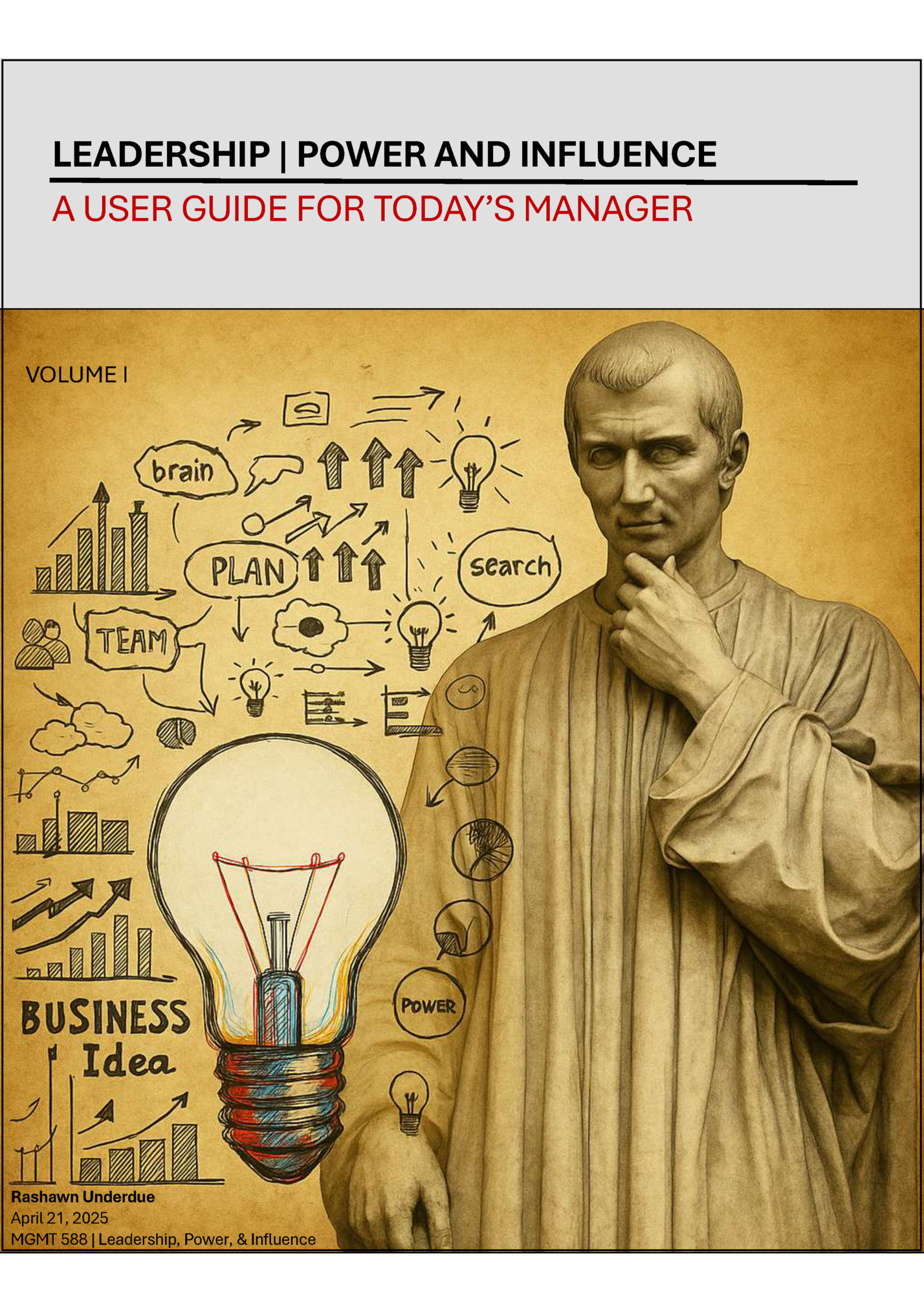
Introduction & Author’s Reflection • Letter from the Curator | My Transformational Leadership Moment (p. 4) • Your Leadership Inflection Point (p. 4) Chapter 1: Bases of Power Understanding Sources of Leadership Influence (p. 6) • Legitimate Power (p. 7) • Reward Power (p. 8) • Coercive Power (p. 9) • Referent Power (p. 10) • Expert Power (p. 11) Chapter 2: Zones of Resistance Diagnosing and Leveraging Employee Commitment (p. 12) • Why We Added the Legitimate Zone (p. 13) • Preference Zone (p. 14) • Indifference Zone (p. 14) • Legitimate Zone (p. 16) • Influence Zone (p. 17) • Non-Influence Zone (p. 18) Chapter 3: Motivational Triggers Know What People Want Before Influence Begins (p. 19) • Intrinsic Motivation (p. 20) • Instrumental Motivation (p. 21) • Self-Concept External (p. 22) Page | 2
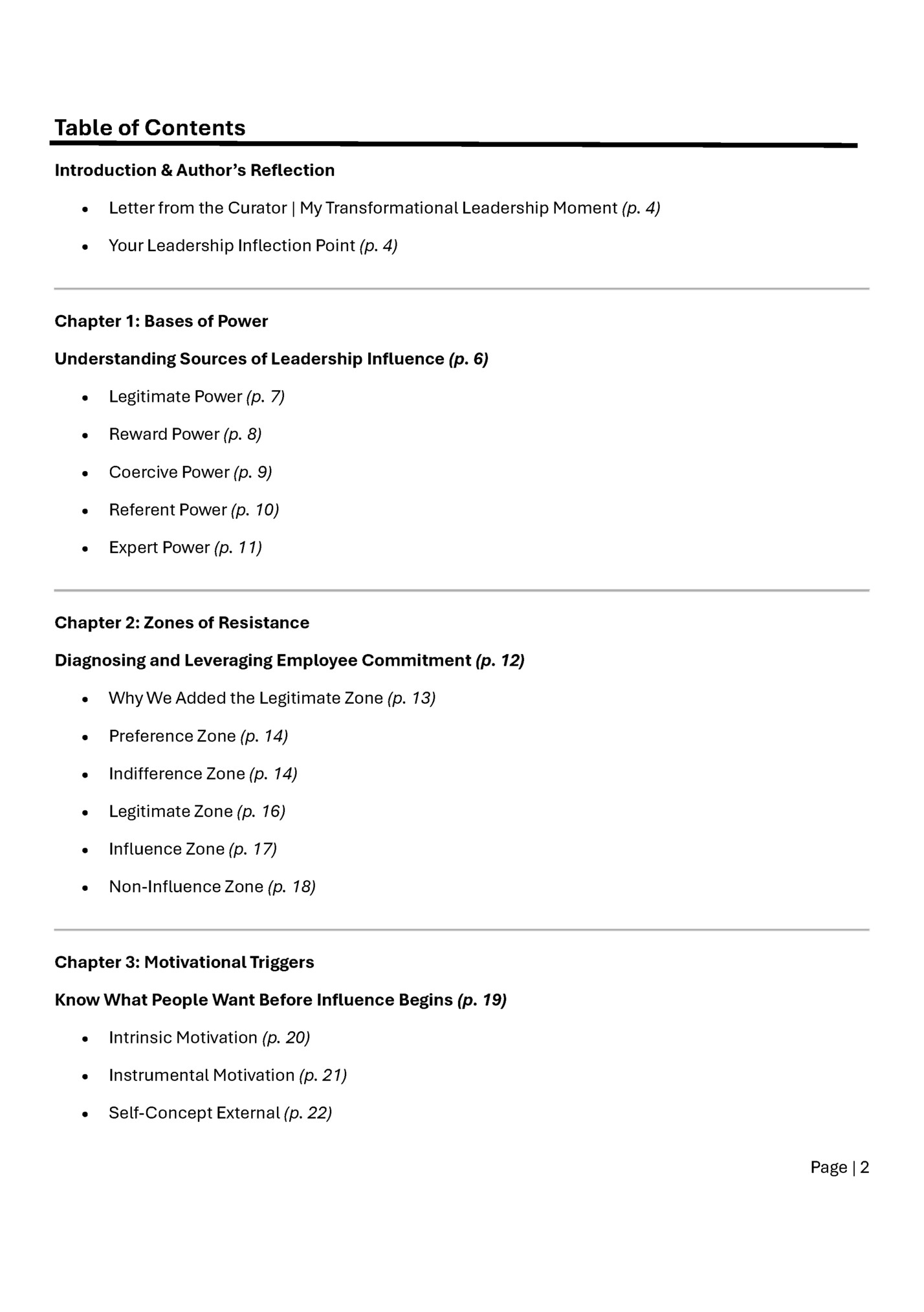
Self-Concept Internal (p. 23) • Goal Internalization (p. 24) Chapter 4: Influence Tactics Strategically Shaping Attitudes, Decisions, and Actions (p. 25) • Rational Persuasion (p. 26) • Inspirational Appeal (p. 27) • Personal Appeal (p. 28) • Consultation Tactic (p. 29) • Exchange Tactic (p. 30) • Coalition Tactic (p. 31) • Legitimating Tactic (p. 32) • Pressure Tactic (p. 33) • Ingratiation Tactic (p. 34) Chapter 5: Dimensions of Political Skill Navigating Organizational Politics with Authenticity and Integrity (p. 35) • Social Astuteness (p. 36) • Interpersonal Influence (p. 37) • Networking Ability (p. 38) • Apparent Sincerity (p. 39) Citation List • Sources & References (p. 40) Page | 3

4/25/25 On the evening of April 22, 2025, at precisely 7:36 PM, in Professor Jay Barbuto's MGMT 588 class – Leadership, Power and Influence, at California State University, Fullerton. My team—Team One—was already 36 minutes late, and the scene we walked into was nothing we had anticipated. We were thrust abruptly into the spotlight, executives from "Parker Brothers," facing a press conference over two tragic choking incidents involving our "Rivington toy. Real cameras rolled. Professional journalists fired sharp, relentless questions. The classroom transformed into a daunting arena, with my classmates watching, expectant and judgmental. As we entered, someone whispered urgently, "Who is your CEO?" My team, instantly unified in silent consensus, turned and pointed directly at me. I stepped forward—and that's when the ambush began. I wish I could tell you I rose heroically. Instead, it felt like a massacre—every preparation from the semester evaporated instantly under the pressure. My mind blanked, my confidence vanished, and I spiraled swiftly back into my default 2.0 self: defensive, emotionally reactive, and tragically immature. Rather than calmly steering the conversation, I met questions with hostility, arrogance, and biting retorts reminiscent of the defensive bravado of a 45/47. Sweat dripped off my brow, the heat of embarrassment intensifying every second. Only in the final two minutes did I grasp the profound, life-changing lesson behind this grueling exercise: Could I execute the strategy, authentically, precisely, and under intense pressure? That night, the answer was no. Yet from that humbling revelation emerged something far more powerful than momentary defeat—a fierce resolve and an unwavering commitment to growth. This experience is liken to be when a disastrous sales meeting led me to discovering Chris Voss's Never Split the Difference. I learned the transformative power of tactical empathy and negotiation. This pivotal lesson reignited my hunger for knowledge, leading me on a remarkable journey back to academia in 2022 and eventually landing me in CSUF's MBA program, guided by the extraordinary Professor Jay Barbuto. Dr. Barbuto has continuously challenged my intellectual limits, reshaped my perceptions, and—even when I believed I'd reached my maximum—quietly demonstrated how much further I could still grow. Only now do I realize how skillfully he orchestrated our entire learning journey, setting the stage for my—and our—most significant breakthroughs. This workbook is the culmination of that journey. It is designed not just as another text, but as a daily companion for rigorous self-reflection, continuous vertical development, strategic analysis, and practical problem-solving. This is my commitment to myself and to every future leader who, like me, refuses ever again to be caught off guard, overwhelmed, or unprepared. It is an enduring promise to my family, customers, colleagues, future students—and especially myself—that no matter what life throws at me, I will always rise equipped, empowered, and inspired to shape the outcomes that matter. I invite you to embark on this journey with the same passionate intensity. Prepare yourself intellectually, emotionally, and practically for the unpredictable terrain ahead. The world is waiting for leaders who can face the storm with clarity, empathy, and precision—and with this workbook in your hands, you now hold the tools to become precisely that kind of leader. Good fortune, see you out on the field. P.S. Thank you Professor Barbuto, for a life shaping experience. Rashawn Underdue California State University, Fullerton – MBA, Class of 2025 Page | 4
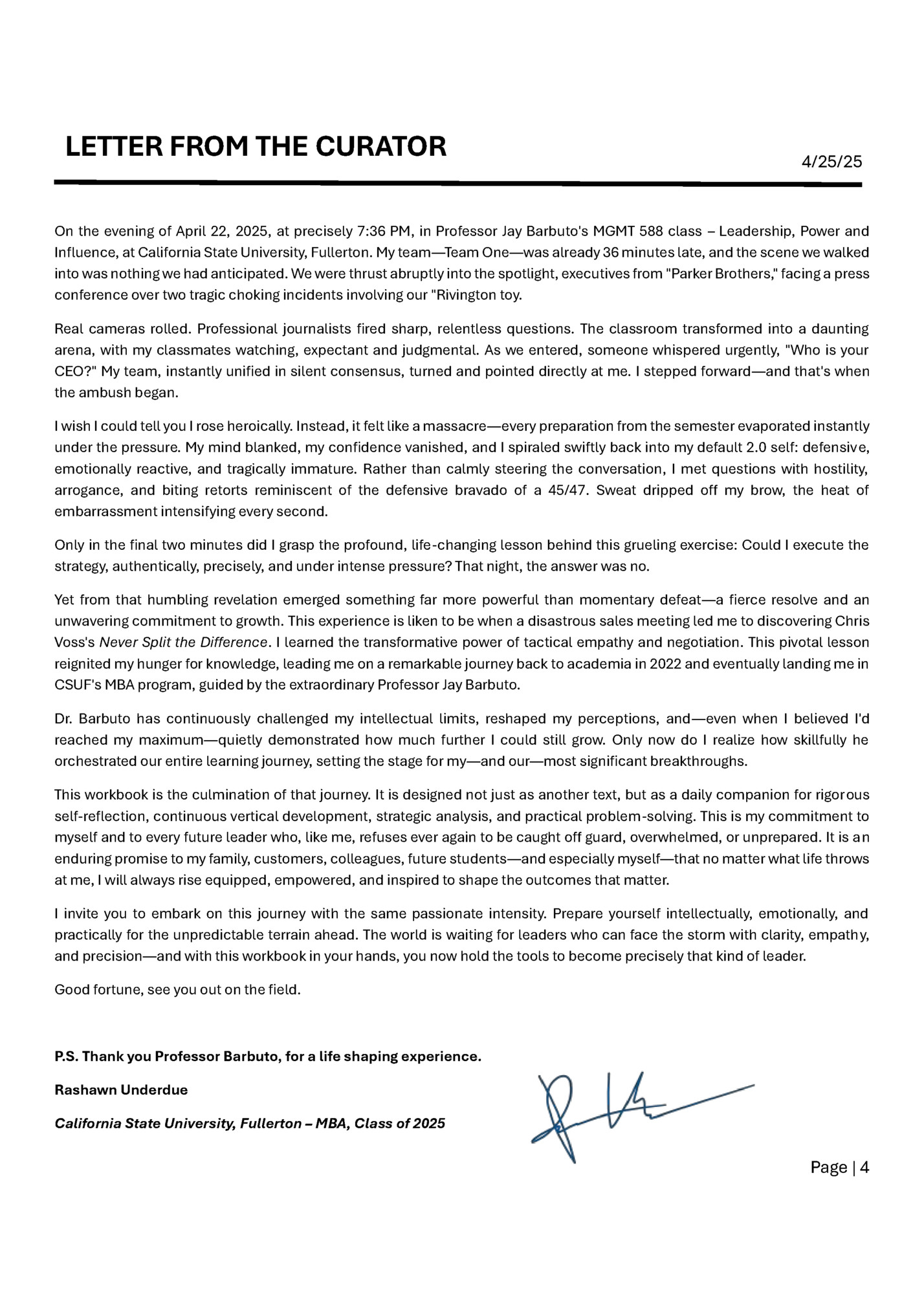
Imagine, for a moment, stepping confidently into every leadership challenge—not armed with mere authority but equipped with deep, unshakable insight into the authentic pulse of human motivation. What if you could inspire compliance, genuine enthusiasm, and unwavering dedication—not because your team must follow, but because they passionately want to? This workbook in your hands isn't designed for passive reading; it's crafted for rigorous engagement, selfreflection, and daily use. Born from transformative experiences and scholarly insights gained through my journey in the MBA Leadership and Organizational Behavior program at California State University, Fullerton—under the visionary guidance of Professor Jay Barbuto, Director of the Leadership Center—this workbook synthesizes advanced organizational theory, evidence-based leadership frameworks, and practical influence tactics into one reliable toolkit for continuous growth, introspection, and strategic action. Every page represents a commitment—not just to leadership but to mastering the nuanced psychology of influence, the art of authentic persuasion, and the intelligent navigation of complex organizational dynamics. Expect to engage deeply and often. This isn't a book you finish—it's a WORKbook you live. It's designed for daily reflection, a trusted reference when uncertain, and a persistent reminder of your commitment to evolve. Every chapter you complete, every insight you internalize, and every question you sincerely explore will shift your approach dramatically, arming you with sophisticated tools to motivate, align, and inspire those you lead at a profound, lasting level. As you immerse yourself in this journey, pause frequently and ask yourself: How would your career, impact, and legacy transform if you mastered the subtle art of aligning human behavior with organizational vision? The tools are here. The insights are ready. All that remains is your decision to lead boldly and intentionally. Your transformation into the leader you were always meant to be starts now. Let's Begin. Page | 5
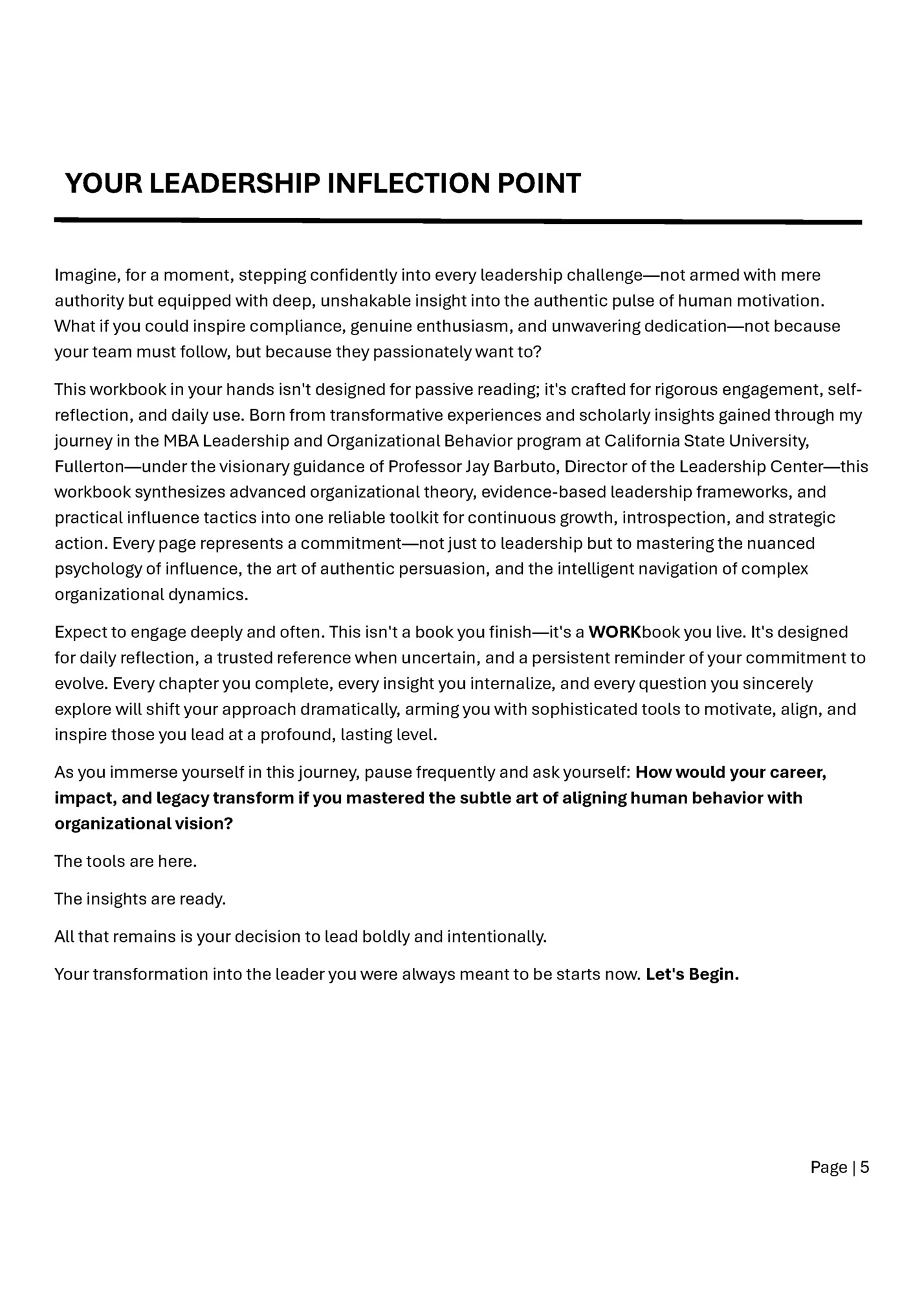
Remember - Power is Given by Those We Seek To Influence. French and Raven identified bases of social power that leaders can draw on (French & Raven's Power Bases: A Tool for Leadership Coaches). Not all power bases are equally effective: some mostly oblige compliance without true buy-in, while others gain commitment and support (The 5 Types of Power Effective Leaders Use). Page | 6
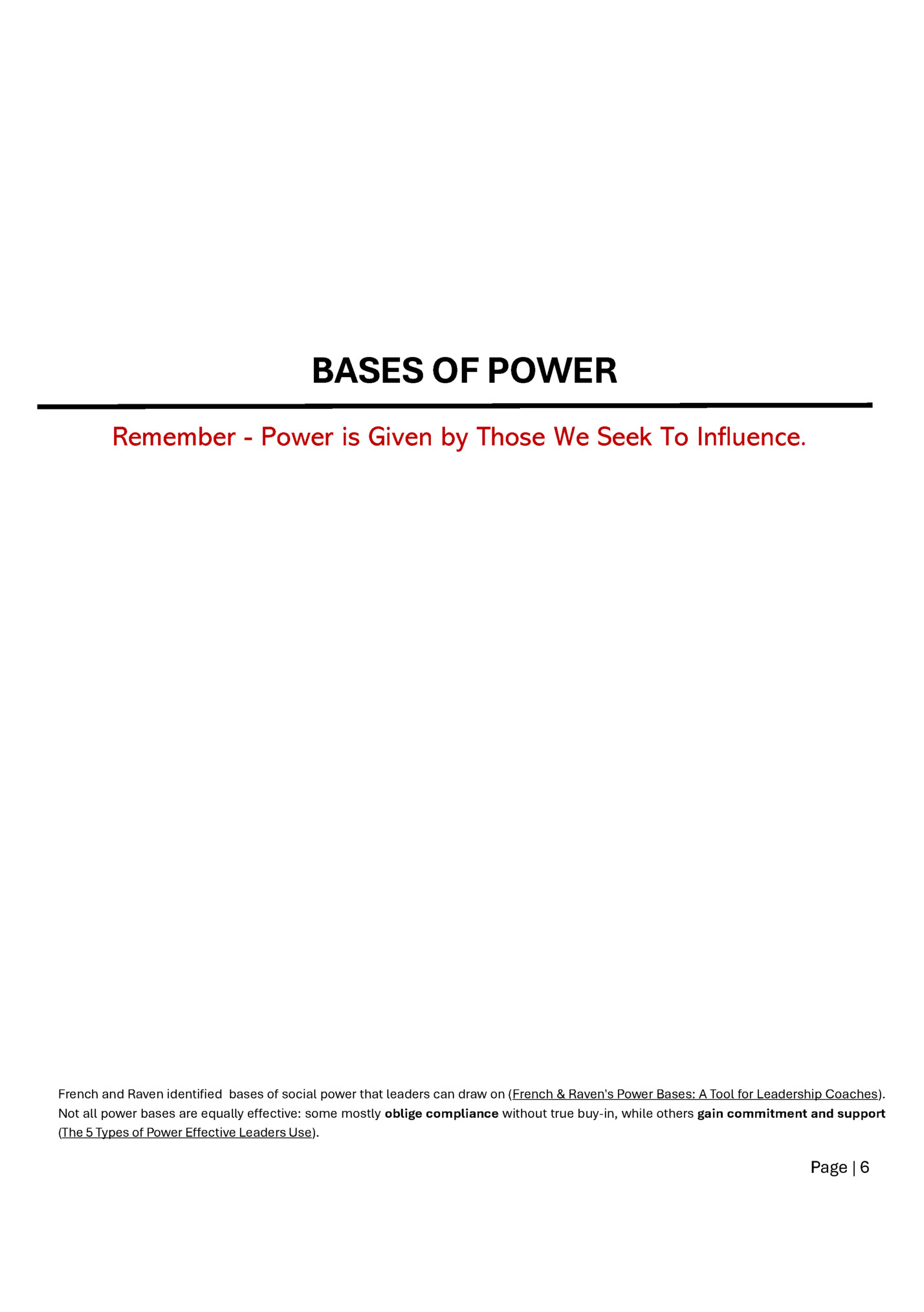
Leadership Frame: Legitimate power is the authority that comes with the role. It’s structural. It’s contractual. It’s the kind of power that says, “Because of my position, this request is within scope.” It’s a foundational tool for any formal leader—and when used correctly, it ensures clarity, consistency, and operational control. But legitimate power isn’t enough to inspire. It works best in environments where expectations are known, tasks are routine, and compliance needs to happen quickly. Overuse, however, can erode morale—turning clear direction into cold bureaucracy. And when this power is underused, it sends a different signal altogether: one of blurred boundaries, inconsistent leadership, or the slow unraveling of operational standards. Used well, legitimate power provides structure in moments of ambiguity. It supports procedural fairness, reinforces team-wide clarity, and prevents confusion about what must get done and who has the right to enforce it. But when over-relied on, it creates a top-down, command-and-control dynamic that stifles input, creativity, and voluntary commitment. Team members begin following the rules—but not following the leader. Neglecting this power also carries cost. Leaders who hesitate to invoke their authority when it’s warranted risk undermining the very standards they are meant to uphold. Without a clear sense of expectations, teams drift into policy fatigue, accountability gaps, and decision paralysis. This power is most effective when it’s used to stabilize— not dominate. It should clarify expectations, not replace collaboration. Leadership Tool Kit How to Measure: Legitimate power is measured by whether people comply with your requests without questioning your authority. Do team members respond to directives without pushback? 360° feedback and self-assessments can confirm if your positional authority is recognized and respected—or if it’s tolerated but not trusted. When to Use: This power is best reserved for routine tasks, safety procedures, or policy enforcement. It’s ideal in moments where clear chain of command is critical—like compliance checks, regulatory updates, or operational standards. Use it when the task “comes with the job”—and your role gives you the right to request it. How to Use: Invoke your role with confidence and clarity: “As your manager, I need everyone to follow this safety procedure.” Back up the request with organizational policy: “This aligns with our standard operating protocols.” Whenever possible, combine with other power bases or Motivation Triggers; to move from obedience to ownership. Avoid using title as a blunt tool. Use it as a door opener—then lead through connection, not command. Leadership Insight: Legitimate power creates order—but must be handled with restraint. When used with confidence and respect, it reinforces trust in leadership and keeps the mission moving. When used without tact or heart, it becomes a wall that separates leaders from their people. Page | 7
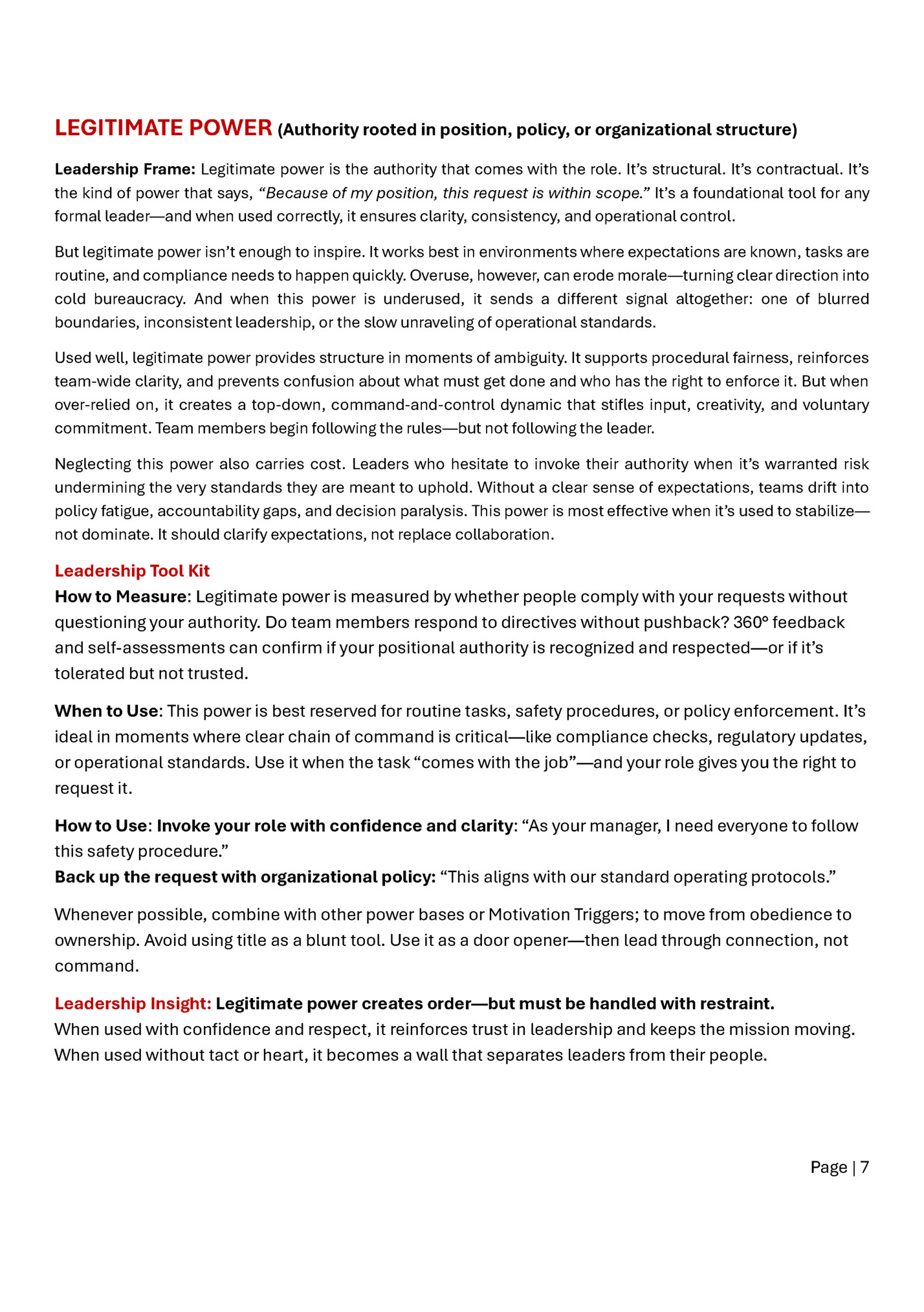
Leadership Frame Reward power is one of the most visible and often-used forms of influence. At its core, it’s the leader’s ability to offer something meaningful—praise, bonuses, time off, new opportunities—in exchange for effort, alignment, or results. Done well, it creates a direct and motivating connection between performance and recognition. Done poorly, it undermines the very culture it’s meant to reinforce. When used strategically, reward power increases motivation, aligns effort with outcomes, and helps shape highperformance norms. It builds emotional momentum inside teams and reinforces the behaviors leaders want to see repeated. It energizes performance during pressure pushes, lifts morale during slowdowns, and turns milestone moments into momentum-building celebrations. But reward power isn’t automatic—it’s earned through timing, consistency, and sincerity. When used carelessly or inconsistently, rewards can feel manipulative or hollow. Overuse leads to dependency—where employees begin expecting something extra for every action, no matter how basic. On the other hand, underuse signals detachment. When recognition is absent, effort fades. People stop reaching because they don’t feel seen. This power becomes most effective when it’s personal, purposeful, and proportionate. The leader who links performance to recognition not only drives results—they reinforce meaning. The goal isn’t bribery. The goal is reinforcement—done with clarity, fairness, and authenticity. Leadership Toolkit How to Measure Reward power is visible in how your team responds to acknowledgment. Are they motivated by your recognition? Do they seek feedback, stretch further, or show increased effort when rewarded? Monitor how often you use incentives—both formal and informal—and whether they result in sustained performance. Use surveys or informal check-ins to ensure rewards are felt as fair and meaningful. When to Use Use reward power to elevate effort during goal-driven sprints, re-engage a discouraged team, or motivate through less appealing tasks. It’s especially powerful when performance is visible and measurable, and when employees know exactly what will earn the reward. It can also reinforce the values and culture you want to scale. How to Use It Link the reward clearly to the contribution: “If we hit this target, Friday is yours.” Match the reward to what the person values—some want time, others visibility. Some just need a moment of sincere praise in front of their peers. The key is relevance and follow-through. Make your recognition felt, not just heard. Leadership Insight Reward power isn’t about buying effort—it’s about reinforcing it. Used wisely, it reminds people that what they give matters, and that what they achieve won’t go unnoticed. Page | 8
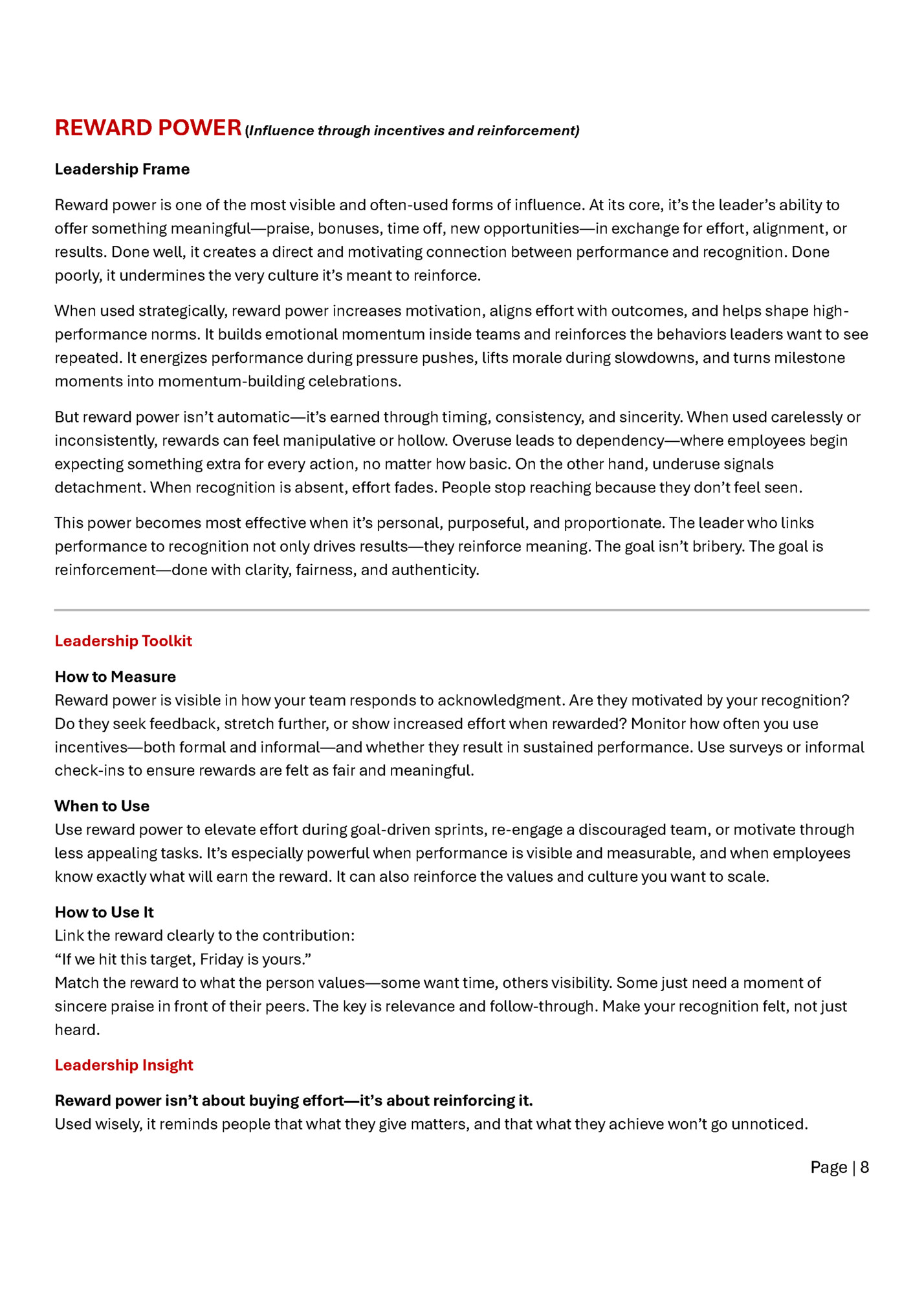
Leadership Frame: Coercive power is the authority to discipline, correct, or enforce consequences when behavior violates expectations, values, or standards. It’s the ability to say, “This is unacceptable,” and back it with corrective action. While no leader wants to lead through fear, the truth is: healthy boundaries require consequences. Used sparingly and fairly, coercive power maintains accountability, protects team integrity, and reinforces the boundaries that uphold safety, ethics, and culture. It’s essential when immediate correction is non-negotiable— cases like harassment, safety violations, chronic noncompliance, or ethical breaches. In those moments, avoiding coercive power isn’t compassion—it’s leadership avoidance. Applied with intention, this power strengthens the organization’s backbone. It affirms that standards matter, that accountability applies to everyone, and that culture is a shared responsibility. But overuse quickly erodes trust. It creates fear-based compliance, not genuine buy-in. Creativity slows. Voices shrink. Morale fades under a surface of forced professionalism. Underuse, however, breeds inconsistency. Leaders who avoid enforcing boundaries—out of fear, guilt, or discomfort—enable dysfunction. They unintentionally reward toxicity and confuse high performers, who start to question why standards are optional for some. The leadership imperative is clear: coercive power is not for control—it’s for clarity. When applied with fairness and transparency, it protects what matters. When misused or ignored, it becomes either corrosive—or invisible when needed most. Leadership Toolkit How to Measure: Coercive power is in play when employees change behavior in response to consequences, rules, or direct accountability. You may notice signs of fear, withdrawal, or avoidance—these are red flags of overuse. On the other hand, if boundary-breaking behavior goes unaddressed, or standards erode without pushback, you may be underutilizing this power. Feedback tools, exit interviews, and climate surveys often reveal whether employees see the system as fair—or fear-driven. When to Use: Use coercive power in clear, high-stakes moments—when harm is being caused, culture is at risk, or standards are being violated. It’s also essential in safety enforcement, ethics infractions, and consistent underperformance that impacts the team. Use it only when other forms of influence have failed, and when the stakes justify the firmness. How to Use It: Set the boundary with clarity: “This behavior is unacceptable, and if it continues, it will have consequences.” Act with consistency: “If we enforce this for one, we enforce it for all.” And when necessary, follow through with professionalism—not punishment. Discipline should never humiliate. It should instruct, correct, and realign. After the correction, reconnect—when the moment is right—to show that boundaries and belief in the person can coexist. Leadership Insight: Coercive power isn’t a weapon—it’s a safeguard. Used well, it builds trust in structure. Used poorly, it breaks trust in leadership. The mark of a mature leader is knowing when to protect the team by holding the line—with clarity, not cruelty. Page | 9
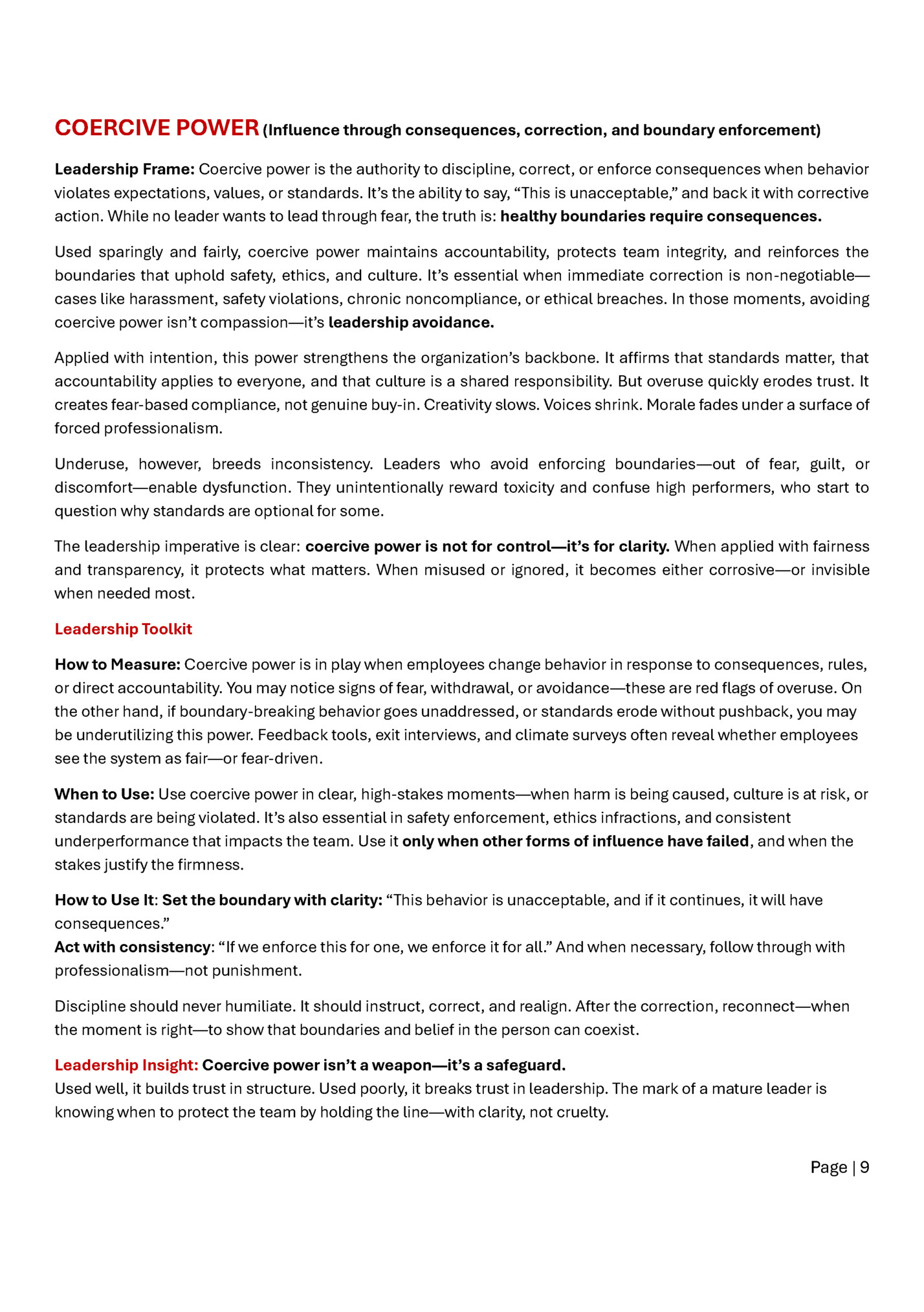
Fleepit Digital © 2021